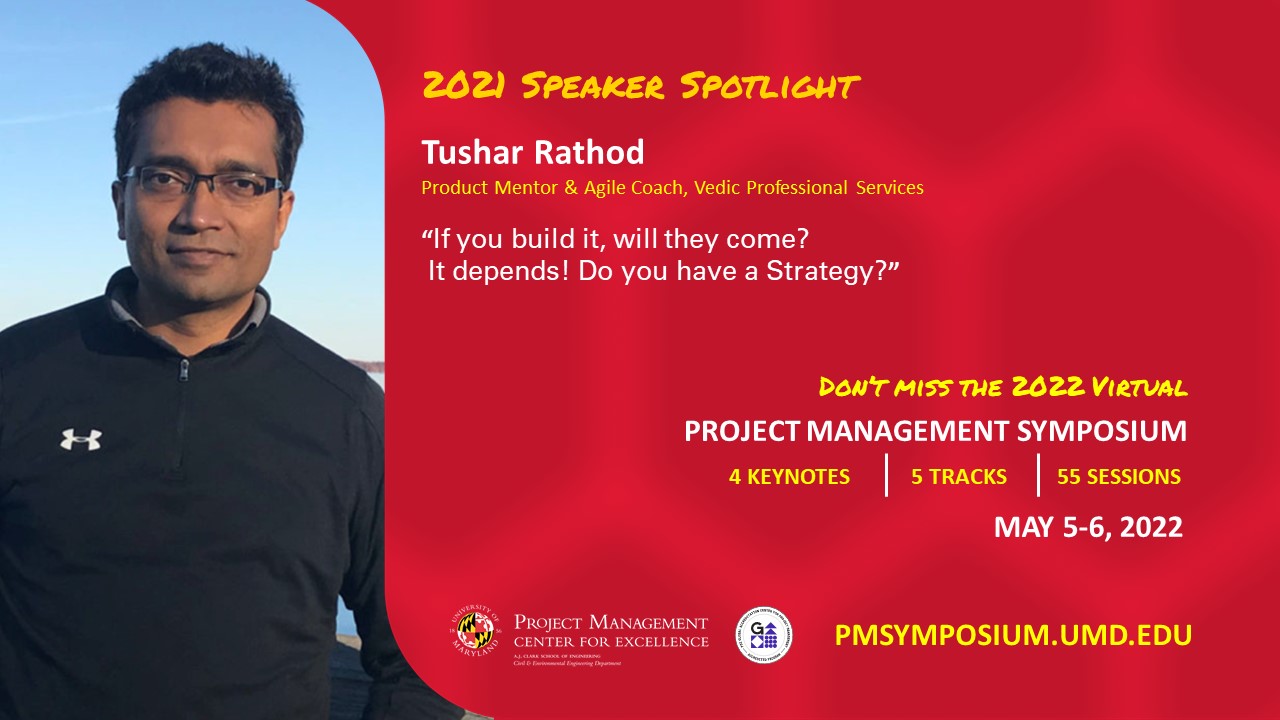In spring of 2021, we received approval to launch a new master’s degree that is a Master of Professional Studies in Product Management. We are jointly offering this degree with the Maryland Technology Enterprise Institute (Mtech), another business unit in the A. James Clark School of Engineering. Since product management is such an important topic, we thought we would share a very informative presentation on the topic from our 2021 Virtual Project Management Symposium .
Our newest adjunct professor, Tushar Rathod, presented on “Product Strategy: Framework and Execution” and explained that a product strategy is more than just an idea and a roadmap. A project strategy is an organizational function that links the needs of the user, the business and the technology with a focus on what to create, and more importantly—explores the why.
A roadmap that explains the steps to completing a product is essential, but it’s not the same as a strategy. Tushar pointed out that not many companies or product managers have defined actual strategies, although they’ve got very detailed plans, or roadmaps, that show how goals can be achieved. It’s not enough.
Plans are about creating certainty and direction. But strategy is a bit more elusive, and no matter how clearly illustrated the goals in the plan might be, the key to success is having a strategy—a set of key choices with an eye toward the as-yet unknown factors in the project that will guide future decisions and move the roadmap forward.
His presentation is a walk-through of what project strategy is, beginning with product fundamentals.
What is a product?
Products are simply a collection of features that provide value to customers, and the goal of managing these products is to maximize the value delivery through a continuous prioritization of effort. A product is different from “Operations” which focuses on consistency, efficiency and predictability of a set or a sequence of tasks. A product is also different from a project in that a project is a one-time lift to a defined end-state. A product, on the other hand, is neither predictable nor does it have a defined end-state; it is a continuous journey of discovering and delivering value. Throughout the life cycle of the product, a product manager is seeking to build capabilities that organizations look for to deliver value rapidly, while expanding on features that the customers need.
Once that’s been clarified, the first fundamental question is simply, “What do I build?” Tushar says this question begins to be answered when the product manager brings the outside-in perspective; that is, when the customer is brought to the table. That’s when the next set of critical questions can be addressed. What are the customer’s specific needs? How will your company’s technology plan ensure the product is feasible and reasonable? Does it all align with the overall business strategy and goals? Through a continuous alignment while answering those questions, an efficient product manager can maximize customer value by evolving the business model and building technical capabilities.
Sound decisions should be based on data. In the absence of all the needed data, a product manager can begin with a good hypothesis, then bring in the data to validate (or invalidate) the hypothesis, always mindful about what’s working or not, and if the product is delivering the expected value or not. For this to happen, a key element is to make sure that the funding models are flexible. If possible, decide at the outset, how much money is needed, but if this information isn’t available, then return to the first questions—who am I building this for and why? Does it align with the business? Can I build this from a technology standpoint? It’s the handshake between these three questions that will define the successful outcome of a product, with funding levels that align appropriately to a product’s lifecycle stage.
The Product Life Cycle
The life story of most successful products is a trackable history of their passing through certain specific, identifiable stages. The first is the product’s introduction into the market (also referred to as 0-1), with a heavy focus on finding ways for it to resonate with the consumers and ensuring that it achieves “stickiness” or adoption. Then during the growth stage, invest in the product heavily in order to expand its reach. The product may then move to maturity, when it might be time to reallocate resources, maximize “profit-taking” and consider what might come next. At last, the product may enter a “decline” stage, during which decisions must be made about whether to reposition the product or retire it.
These are very complex aspects and addressing them may require the use of one of the key elements in product management: experimentation. They may also lead to the creation or re-prioritization of organizational capability roadmap with focus on additional capabilities we might want to build that can be used by multiple products. From there, these considerations may inform the build of a product roadmap that may build reusable feature sets that support or enhance current (or future) products.
What are the team’s roles?
Effectively scaling a product team means the product manager must be able to consider the big picture. How do all the individuals work together, and how can we help them operate as efficiently as possible? This is where the product team’s structure is critical and finding ways to make sure the team stays together as the product expands is one of the product manager’s highest priorities.
Who’s on the team? As always, the product manager is at the helm, focusing on the what and the why. Typically, there’s also a product owner, whose delivery team focuses on interdependent deliverables and deadlines. On an Agile Scrum project, there’s servant-leader scrum master; UX/UI resources who focus on building a deep understanding of the customer through persona research, user testing and prototyping. There’s also a project manager, who’s in charge of the product’s release, risk management, communications and documentation. And finally, the team members, whose skills are cross-functional. All have different, but key roles in terms of managing the product’s life cycle.
What’s the vision for the product?
Whereas a product roadmap focuses on achieving specific goals, the strategy is the realm in which intangible factors are discussed, such as the product’s vision. In the strategy, we can talk about what we’re doing and why. This is where we talk about the choices we’re going to make, the context in which those choices are being made, and how to structure it all, depending on the product and the company’s business strategy.
The product vision explores the why; it’s simple and ambitious, yet attainable. It inspires the team and it’s in alignment with the company’s mission. There must be clarity about the vision at the company’s highest level, which aligns with and informs the vision of individual products. Clarity is critical for alignment, shared understanding and collective success and as Einstein said, “If you can’t put it simply, you don’t understand it fully.”
Establishing OKRs
The next step in the product strategy is to create a simple OKR framework, consisting of Objectives, Key Results, and Measures of Success. This provides a clear, simple way to implement your strategy, make sure you’re aligning with the product, multiple products — or even with the entire enterprise — and creates an overall coherent picture. It’s key to laying the foundation for successful implementation. There are subjective elements to be determined here: Where is the product going? What are we trying to accomplish? These elements are action-oriented; they define the product’s target value, and the time period involved. Stating clearly: Within this period of time, we want this much progress, measured this way” is the premise of a key result(s).
Success measures based on outcomes vs. outputs
Success measures are equally important; how did we know if we were successful in terms of what we set out to do? We define success measures early so that we can shape them, and it’s important to note that these are based on outcomes, not outputs. That means, it’s not enough to say we had this number of people working, and we deployed so many lines of code. The real question is, what value did it actually deliver? That’s what an outcome is, with a target value for what we need to achieve.
Tushar expanded further on outputs versus outcomes in the context of success measures. A backlog may be a collection of actionable outputs that a team has to work on; it needs to be constantly prioritized based on the hypothesis and the data. Outcomes, on the other hand, focus on the value delivered to the customer, business or stakeholder(s). Outcomes are best represented on a Roadmap, which is a high-level timeline, but not a schedule. Outcomes are about delivering value, creating impact, changing behavior, and ensuring return on investment from the investor or customer standpoint. Use success measures to see if you delivered success to the degree expected, within the timeframe defined. Sometimes, measuring outcomes takes time and is ambiguous, so allowing flexibility in the framework helps.
Continuous feedback
Product growth is driven by asking and answering several key questions throughout its life cycle – a continuous feedback loop. We are constantly learning from what is happening, what is working, and then adapting to new scenarios. The scope of the product will evolve constantly, and a product manager must be doing the highest priority work at any given time. During this time, we consider megatrends like the impact of COVID, inflation, interest rates, and what that could mean for the product’s life cycle.
Always, the product manager is trying to understand the customer’s viewpoint on these trends and finding out how their needs might be shifting. The product manager is also talking to internal resources in the organization, including sales and customer service, because they all have data and understanding that is vital to consider when making critical decisions about the product.
Asking these and many other fundamental questions throughout the product’s life cycle is what shapes the product and drives growth. Find out what the customer’s pain points are, understanding the gaps out there, what our competitors are doing, and how the landscape is shaping up will help determine the solutions to prioritize.
Staying competitive
Product managers who know how to execute good strategies are made, not born. Tushar says the most effective ones know how to stay competitive beyond the here and now, and stay in alignment with where customers are going, while always keeping an eye on building out the future.
In this article we have introduced you to product strategy, product fundamentals, the product life cycle, product team roles, OKRs, success measures, the importance of continuous feedback, and staying competitive.
If you are interested in presentations like this, and on a variety of other Project Management topics, check out the University of Maryland’s VIRTUAL Project Management Symposium to be held May 5-6, 2022. The event will feature 4 keynote speakers and 55 individual sessions in 5 concurrent tracks. More information can be found at the Symposium website. If you want access to the recording of Tushar Rathod’s presentation, along with 56 other project management related sessions, you can register for access to the recordings from the 2021 Symposium for only $150.
Posted by Kathy Frankle on November 11, 2021

 Data Analytics for the Project Manager
Data Analytics for the Project Manager
